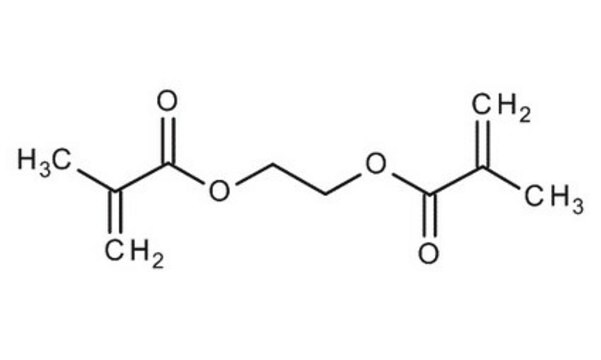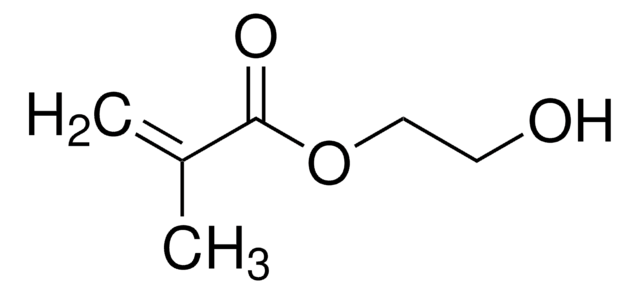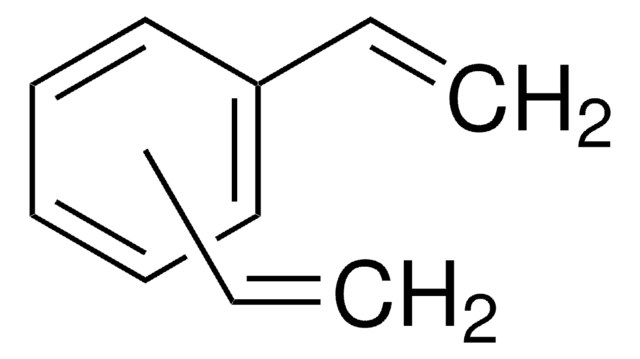Wichtige Dokumente
335681
Ethylenglykoldimethacrylat
98%, cross-linking reagent polymerization reactions, methacrylate, 90-110 ppm monomethyl ether hydroquinone as inhibitor
Synonym(e):
1,2-Ethandiol-dimethacrylat, Ethylendimethacrylat
About This Item
Empfohlene Produkte
Produktbezeichnung
Ethylenglykoldimethacrylat, 98%, contains 90-110 ppm monomethyl ether hydroquinone as inhibitor
Dampfdichte
>1 (vs air)
Qualitätsniveau
Dampfdruck
<0.1 mmHg ( 21.1 °C)
Assay
98%
Form
liquid
Enthält
90-110 ppm monomethyl ether hydroquinone as inhibitor
Eignung der Reaktion
reagent type: cross-linking reagent
reaction type: Polymerization Reactions
Brechungsindex
n20/D 1.454 (lit.)
bp
98-100 °C/5 mmHg (lit.)
Dichte
1.051 g/mL at 25 °C (lit.)
Ω-Ende
methacrylate
α-Ende
methacrylate
Polymerarchitektur
shape: linear
functionality: homobifunctional
Lagertemp.
2-8°C
SMILES String
CC(=C)C(=O)OCCOC(=O)C(C)=C
InChI
1S/C10H14O4/c1-7(2)9(11)13-5-6-14-10(12)8(3)4/h1,3,5-6H2,2,4H3
InChIKey
STVZJERGLQHEKB-UHFFFAOYSA-N
Suchen Sie nach ähnlichen Produkten? Aufrufen Leitfaden zum Produktvergleich
Verwandte Kategorien
Allgemeine Beschreibung
Anwendung
- Ein Terpolymersystem, Poly(acrylnitril-co-ethylen-glycoldimethacrylat-co-vinylbenzylchlorid), das als Sorptionsmittel in der pharmazeutischen Adsorptionanwendbar ist.
- PVA(Polyvinylalkohol)-basiertes Hydrogel durchfreie Radikalpolymerisation. Diese PVA-Polymer-Netzwerke können als Arzneimittelabgabesystemeverwendet werden.
Signalwort
Warning
H-Sätze
Gefahreneinstufungen
Skin Sens. 1 - STOT SE 3
Zielorgane
Respiratory system
Lagerklassenschlüssel
10 - Combustible liquids
WGK
WGK 1
Flammpunkt (°F)
219.2 °F - Pensky-Martens closed cup
Flammpunkt (°C)
104 °C - Pensky-Martens closed cup
Persönliche Schutzausrüstung
Eyeshields, Faceshields, Gloves, type ABEK (EN14387) respirator filter
Hier finden Sie alle aktuellen Versionen:
Besitzen Sie dieses Produkt bereits?
In der Dokumentenbibliothek finden Sie die Dokumentation zu den Produkten, die Sie kürzlich erworben haben.
Kunden haben sich ebenfalls angesehen
Artikel
The manufacture of monomers for use in ophthalmic applications is driven by the need for higher purity, improved reliability of manufacturing supply, but ultimately by the need for the increased comfort, convenience, and safety of contact lens wearers. Daily wear contact lenses have the potential to fill this need for many customers; however, their widespread use is constrained by higher costs compared to weekly- or monthly-based lenses. New approaches that improve cost structure and result in higher quality raw materials are needed to help make contact lenses more affordable and accelerate growth of the contact lens market.
Unser Team von Wissenschaftlern verfügt über Erfahrung in allen Forschungsbereichen einschließlich Life Science, Materialwissenschaften, chemischer Synthese, Chromatographie, Analytik und vielen mehr..
Setzen Sie sich mit dem technischen Dienst in Verbindung.










